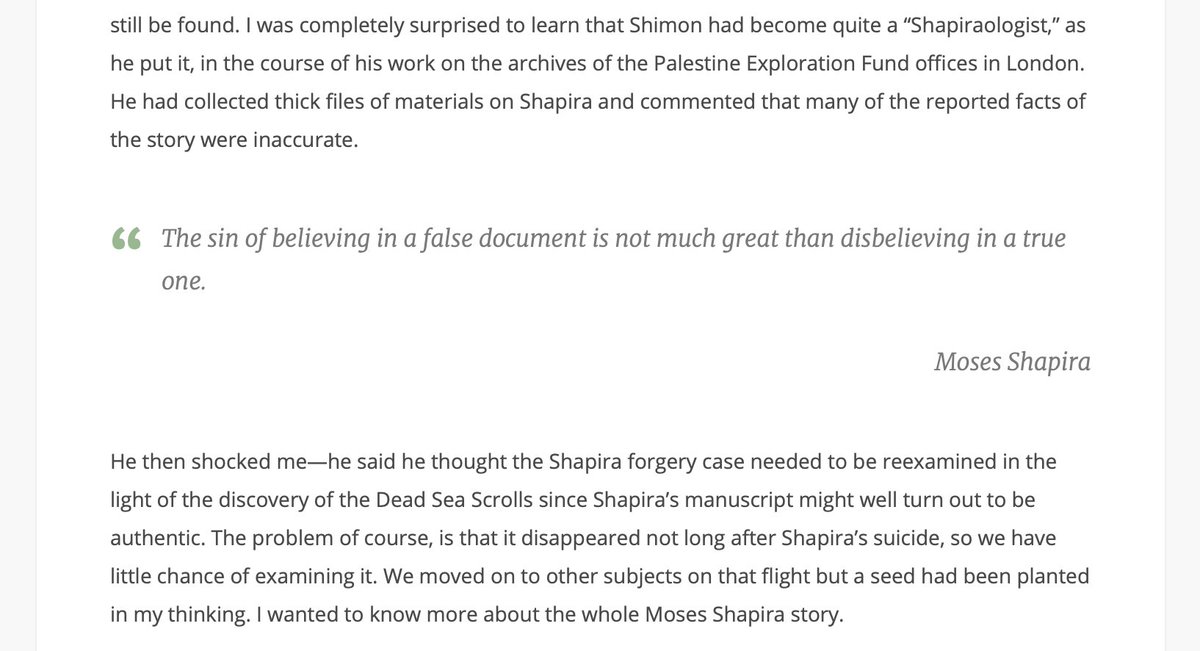
Feels like the IAA is saying *TAKE THAT, MOSES SHAPIRA*
haaretz.com/archaeology/.p…
haaretz.com/archaeology/.p…
To be clear, these new find is *not* from Qumran -- it consists of fragments of a slightly later Bar Kokhba scroll from Wadi Murabba'at (Nahal Darga) to the south. 

The find was part of the operation started in 2017 to survey the Judean Desert.
What Haaretz doesn't tell us -- it's only hinted at by the reference to the Civil Administration -- is that most of the Judean Desert, including Murabba'at, is in the West Bank.
What Haaretz doesn't tell us -- it's only hinted at by the reference to the Civil Administration -- is that most of the Judean Desert, including Murabba'at, is in the West Bank.

The Times of Israel, whose report is on the whole better than Haaretz's, does makes it clear that most of the Judean Desert is in the West Bank.
(It doesn't specify about the findspot of the new fragments at Murabba'at, though.)
timesofisrael.com/bible-scroll-f…
(It doesn't specify about the findspot of the new fragments at Murabba'at, though.)
timesofisrael.com/bible-scroll-f…

The news reports make clear that the discoveries announced today are part of a large-scale survey project (with targeted excavation of specific caves) started in 2017. 

There have been occasional references in news reports to this survey/excavation project, but the IAA has been fairly secretive about it before now.
(Here, from an article in January 2019)
(Here, from an article in January 2019)
https://twitter.com/MichaelDPress/status/1085541799970725889
Israeli work in the area of the Dead Sea caves (mostly in the West Bank) has for a long time been framed as a race against looters -- even though before now it seems like they always lost out by 60+ years
(See the thread here from 2019)
(See the thread here from 2019)
https://twitter.com/MichaelDPress/status/1085543533300330496
We see the same framing here too, coming right from the director of the IAA ("rescue . . . from the robbers' clutches), but now to request additional resources from the state
(This is from the press release)
(This is from the press release)

This promo video is remarkable, with production values unlike any I've ever seen for an IAA video: dramatic music (highlighting the drama, and the threat of looters specifically), voice actors, etc. 

This reads like a nice multicultural sentiment, until you remember the project is taking place in the West Bank w/o regard for international law or Palestinian cooperation. 
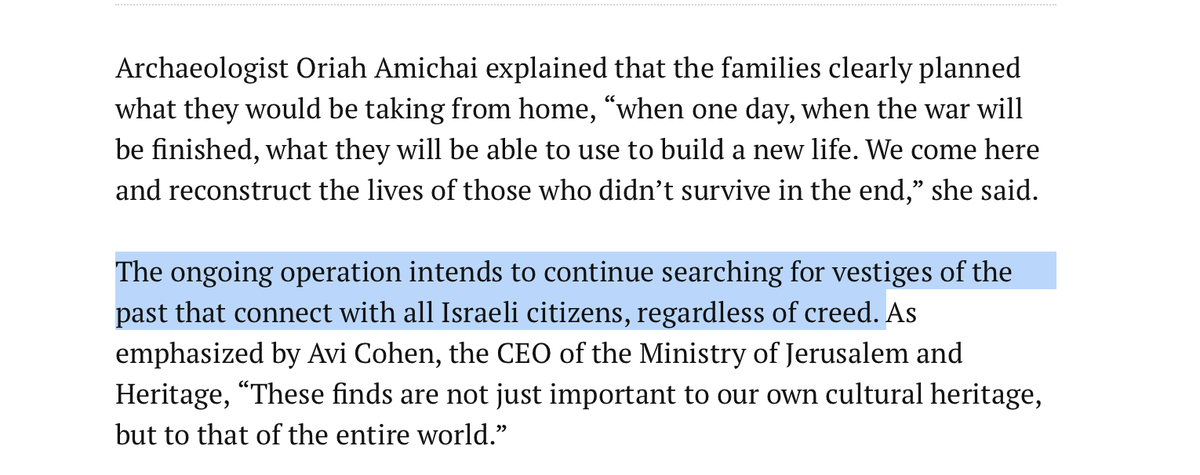
All of the news outlets report that since 2017 this project has surveyed "80 kilometers". Is this square kilometers? The news reports get it straight from the press release which uses the same phrase, unhelpfully. 

If you're interested in more details on the scroll fragments themselves, and to see the promo video, read the Times of Israel piece.
timesofisrael.com/bible-scroll-f…
timesofisrael.com/bible-scroll-f…
Meanwhile this might be my favorite part of the entire episode.
(The last several thousand years are just "the dust on the surface" as the late Ofer Bar-Yosef would say.)
(The last several thousand years are just "the dust on the surface" as the late Ofer Bar-Yosef would say.)
https://twitter.com/mokersel/status/1371829568189906947
Finally, as @ymiller419 points out, there's an election in Israel next week, so we can't rule out political influence on the timing of the announcement.
CORRECTION: I misread this; the scroll fragments are not from Wadi Murabba'at or elsewhere in the West Bank, but the "Cave of Horror" in Israel proper.
(Some of the other finds, like the prehistoric basket, come from Murabba'at)
Apologies.
(Some of the other finds, like the prehistoric basket, come from Murabba'at)
Apologies.
https://twitter.com/MichaelDPress/status/1371745154802012161
For additional details of the finds -- and how the IAA and Israeli media are presenting them -- check out the Times of Israel's "Daily Briefing" podcast
timesofisrael.com/podcast-daily-…
timesofisrael.com/podcast-daily-…
Highlights:
The TOI journalist covering the story (A. Borschel-Dan) notes that the West Bank is occupied -- but then celebrates that the IAA and COGAT are working together:
“For the first time there are NO BORDERS, and they’re working together to prevent LOOTING”
The TOI journalist covering the story (A. Borschel-Dan) notes that the West Bank is occupied -- but then celebrates that the IAA and COGAT are working together:
“For the first time there are NO BORDERS, and they’re working together to prevent LOOTING”
If Borschel-Dan is accurately quoting the archaeologist, it's just bonkers.
First, the scroll fragments were found in a cave excavated in the 1950s -- even thought to be missing pieces of a scroll found then -- and yet were still there 60+ years later . . .
First, the scroll fragments were found in a cave excavated in the 1950s -- even thought to be missing pieces of a scroll found then -- and yet were still there 60+ years later . . .

There's seriously know way they could know this.
Second, the countries around Israel all have stricter antiquities laws than Israel, and items are regularly smuggled *into* Israel in order to launder them for sale.
(You couldn't do this with a scroll fragment but still . . .)
Second, the countries around Israel all have stricter antiquities laws than Israel, and items are regularly smuggled *into* Israel in order to launder them for sale.
(You couldn't do this with a scroll fragment but still . . .)

More: Borschel-Dan reports the survey has covered about 500 caves so far, and (according to Amir Ganor, head of the IAA's robbery prevention unit) there is about 25 percent of the survey left to do.
This is Stage 1: survey with brief excavations in a few (previously dug?) caves
This is Stage 1: survey with brief excavations in a few (previously dug?) caves
Stage 2 is "proper excavation" of about 20 caves that "look promising"
The goal (quoting or paraphrasing Ganor) is "to clean them out before the looters come"
The goal (quoting or paraphrasing Ganor) is "to clean them out before the looters come"
Ah yes, the old *we can ignore international law because the Green Line didn't exist in antiquity* defense
nytimes.com/2021/03/16/wor…
nytimes.com/2021/03/16/wor…

More details on the discoveries from the Times of Israel: some of those Borschel-Dan shared in the podcast and some new ones.
timesofisrael.com/dead-sea-scrol…
timesofisrael.com/dead-sea-scrol…
We're told of how the material in the Cave of Horror was found despite the fact it had already been excavated:
The scroll fragments were found in sifting Aharoni's leftover dirt.
But elsewhere the fragments have been reported as around 20, now it's 80? Or is this a typo?
The scroll fragments were found in sifting Aharoni's leftover dirt.
But elsewhere the fragments have been reported as around 20, now it's 80? Or is this a typo?
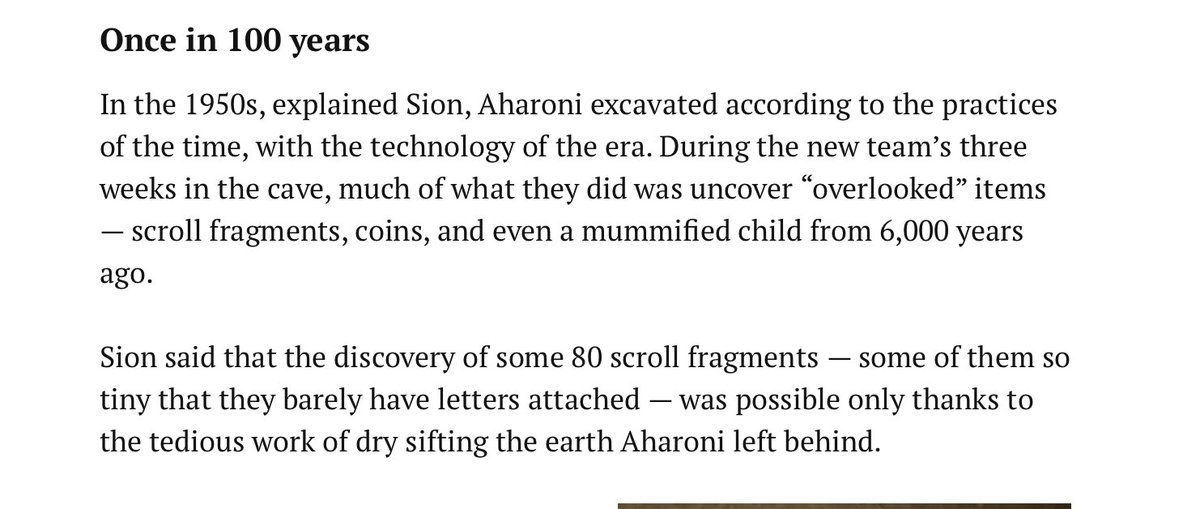
Finally, here's how Borschel-Dan renders Uziel's quote (about if they had waited even 2 more weeks; see above) in this article.
As his fear, it's not the same bizarre claim but it's still sensationalist. (Any archaeologist might fear any site could be looted at any time.)
As his fear, it's not the same bizarre claim but it's still sensationalist. (Any archaeologist might fear any site could be looted at any time.)
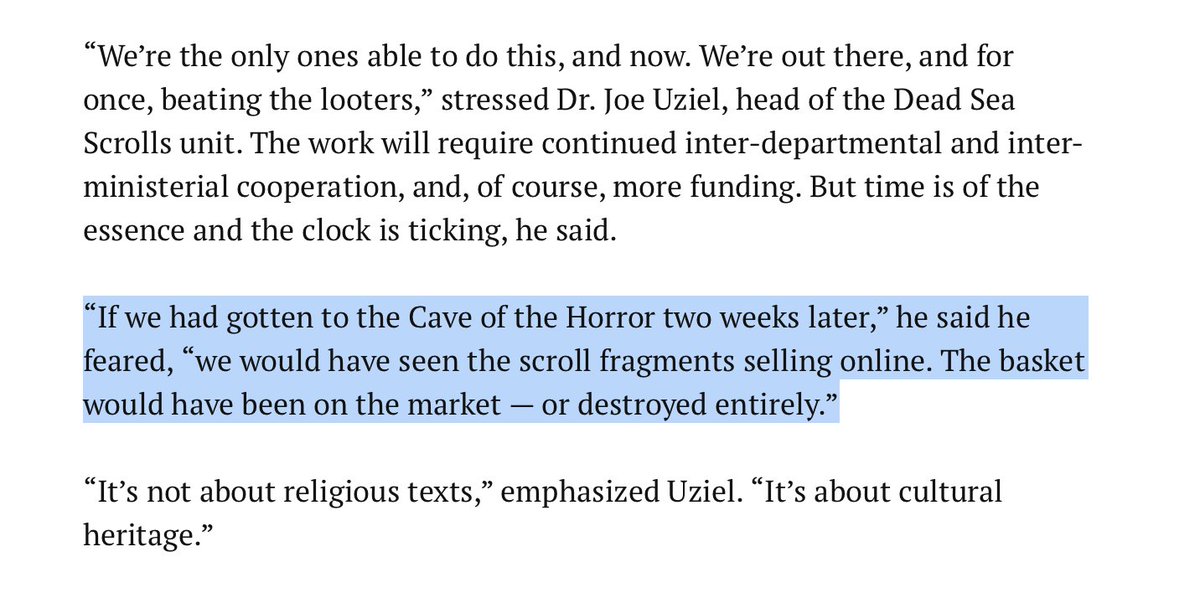
NPR's account gets into the politics and controversy of excavation in the West Bank (good) but is also a little puzzling.
h/t @mokersel
npr.org/2021/03/16/977…
h/t @mokersel
npr.org/2021/03/16/977…
One oddity: According to the article, Amir Ganor (head of the IAA's robbery prevention unit) said the IAA was alerted to the potential for more scrolls in the cave by the discovery of the "Jerusalem papyrus" -- except that this is very likely a forgery. 
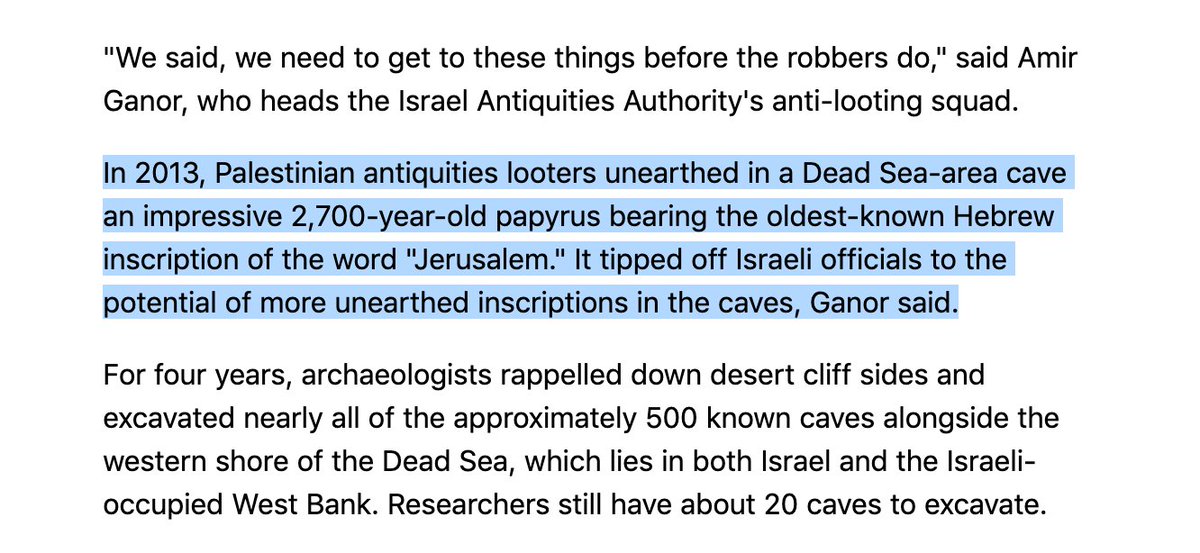
This makes me wonder: are *any* of these more recent appearances of scrolls on the market authentic? 

If you're looking for more on the "Jerusalem papyrus", you might start with this thread:
https://twitter.com/MichaelDPress/status/791621433239609344
The Jerusalem Post has a follow-up interview with two of the IAA archaeologists involved with the project.
h/t @rogueclassicist
jpost.com/archaeology/de…
h/t @rogueclassicist
jpost.com/archaeology/de…
Previously the Times of Israel reported that 75% of the survey area ("80 km") had been covered, including some 500 caves.
Now Eitan Klein tells JPost some 60-70% of the area covered (including about 600 caves) with "40 km" more to go. 🤔
Now Eitan Klein tells JPost some 60-70% of the area covered (including about 600 caves) with "40 km" more to go. 🤔

Again an IAA archaeologist repeats that a goal (not "the" goal) is to save antiquities from looters, & we are told that archaeologists have found their remains -- in this survey, or in general? Did Klein say this?
(It's not helpful this isn't a direct quote & has no attribution)
(It's not helpful this isn't a direct quote & has no attribution)

• • •
Missing some Tweet in this thread? You can try to
force a refresh







